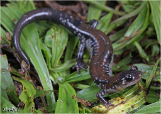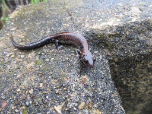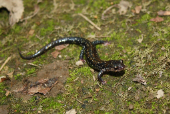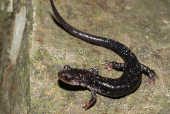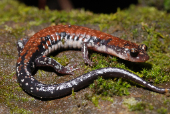Rich Mountain Salamander (Plethodon ouachitae)
Description: Rich Mountain salamanders grow to a length of about 2.0 inches, snout to vent. They are mottled and slatey-grey in colour which makes them inconspicuous. There are glands on their backs which secrete a noxious substance to deter predators. The distinct lineages present characteristic color variations, corresponding with the mountain range where found.
Habitat: Their habitat is mixed deciduous woodland particularly on north facing slopes near wet seeps. They are also found in the characteristic talus rock glaciers of the Ouachitas, under logs, rocks and debris and in cave entrances.
Range: The Rich Mountain salamander was first collected at Rich Mountain east of Page, Oklahoma in the Ouachita Mountains. They only occur on six distinct mountains; Buffalo, Winding Stair, Black Fork, Kiamichi, Round, and Rich Mountain. It has been described as a sky island species due to the strict high elevation of the range. Where their range overlaps that of the Fourche Mountain salamander (Plethodon fourchensis), some hybridization occurs.
Found in these States:
AR |
OK
Diet: The juveniles occupy the same habitat as the adults and both feed among the leaf litter on small invertebrates such as insects and their larvae, worms and spiders.
Reproduction: Breeding takes place terrestrially by direct development.
Status: Listed as Near Threatened because the continued survival of this species is dependent on the protection and management of its habitat provided by Ouachita National Forest. Without this level of protection, it is very likely that the speciesí habitat would be degraded and fragmented resulting in significant population declines, which would warrant an immediate uplisting.
»» Kingdom: Animalia - Animals
»» Phylum: Chordata - Chordates
»» Subphylum: Vertebrata - Vertebrates
»» Class: Amphibia - (Amphibians)
»» Order: Caudata - Salamanders
»» Family: Plethodontidae - Lungless Salamanders
»» Genus: Plethodon
»» Species: Plethodon ouachitae - Rich Mountain Salamander
This article uses material from the Wikipedia article "Rich Mountain Salamander", which is released under the Creative Commons Attribution-Share-Alike License 3.0. Content may have been omitted from the original, but no content has been changed or extended.
|





